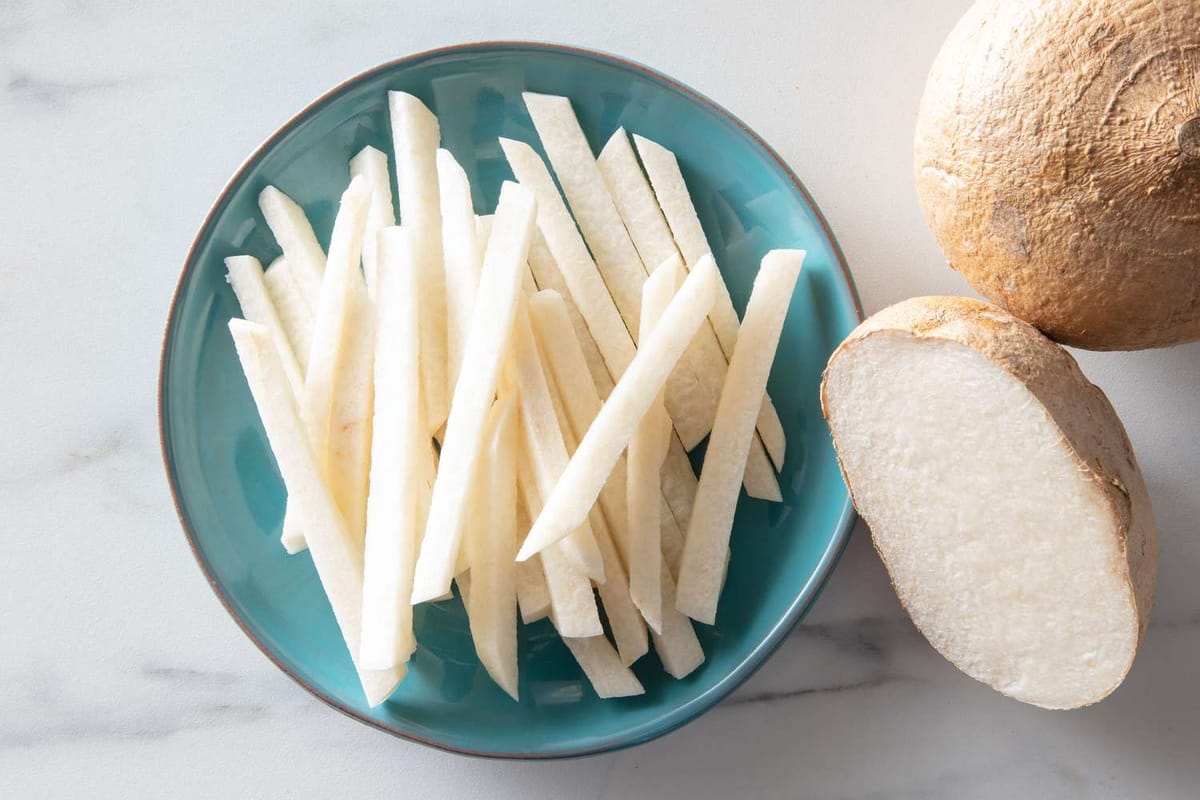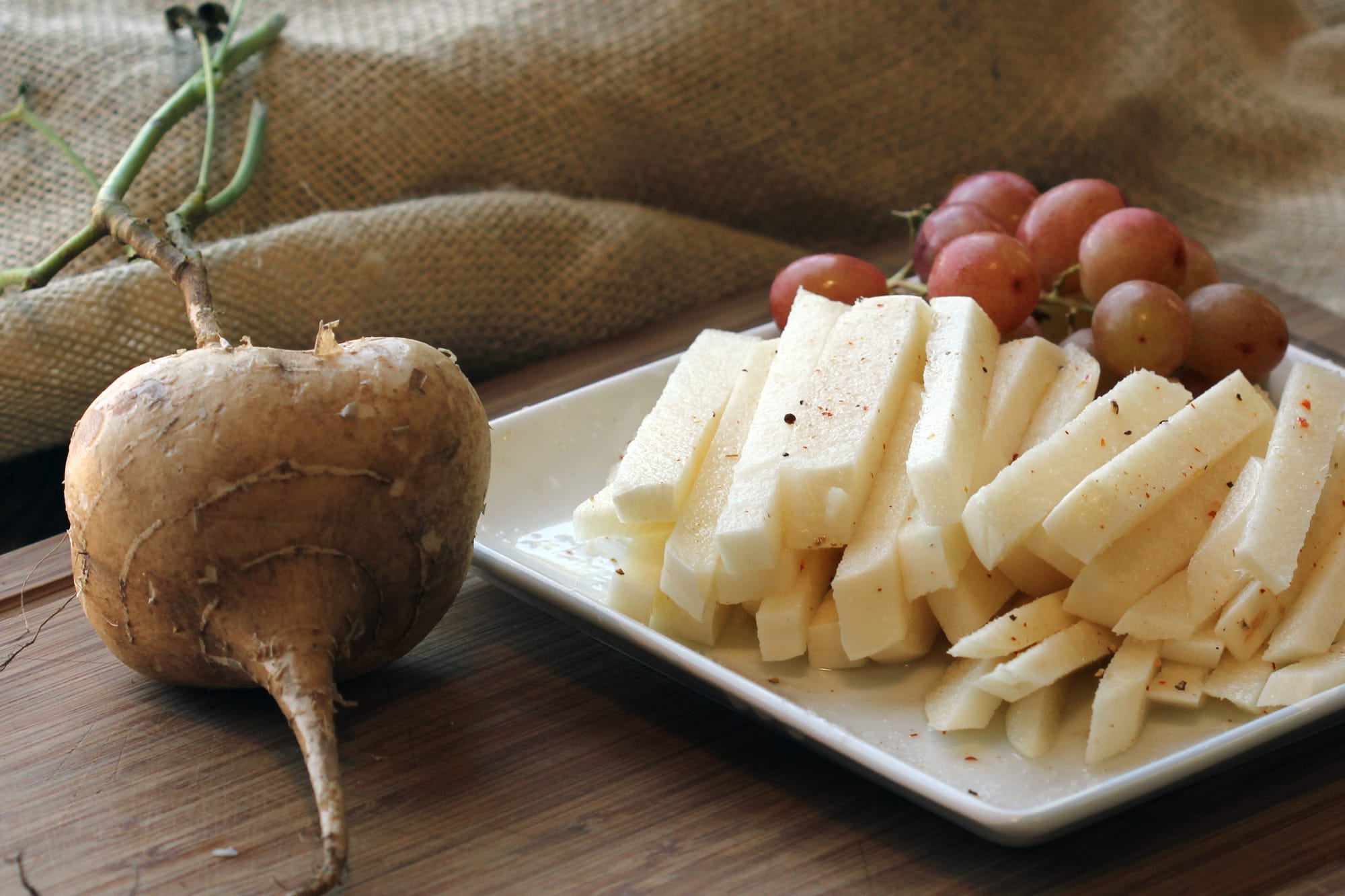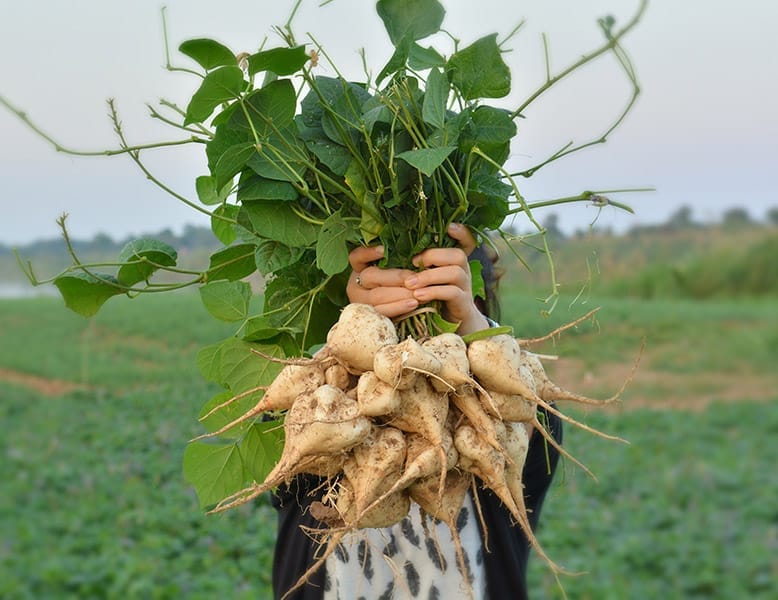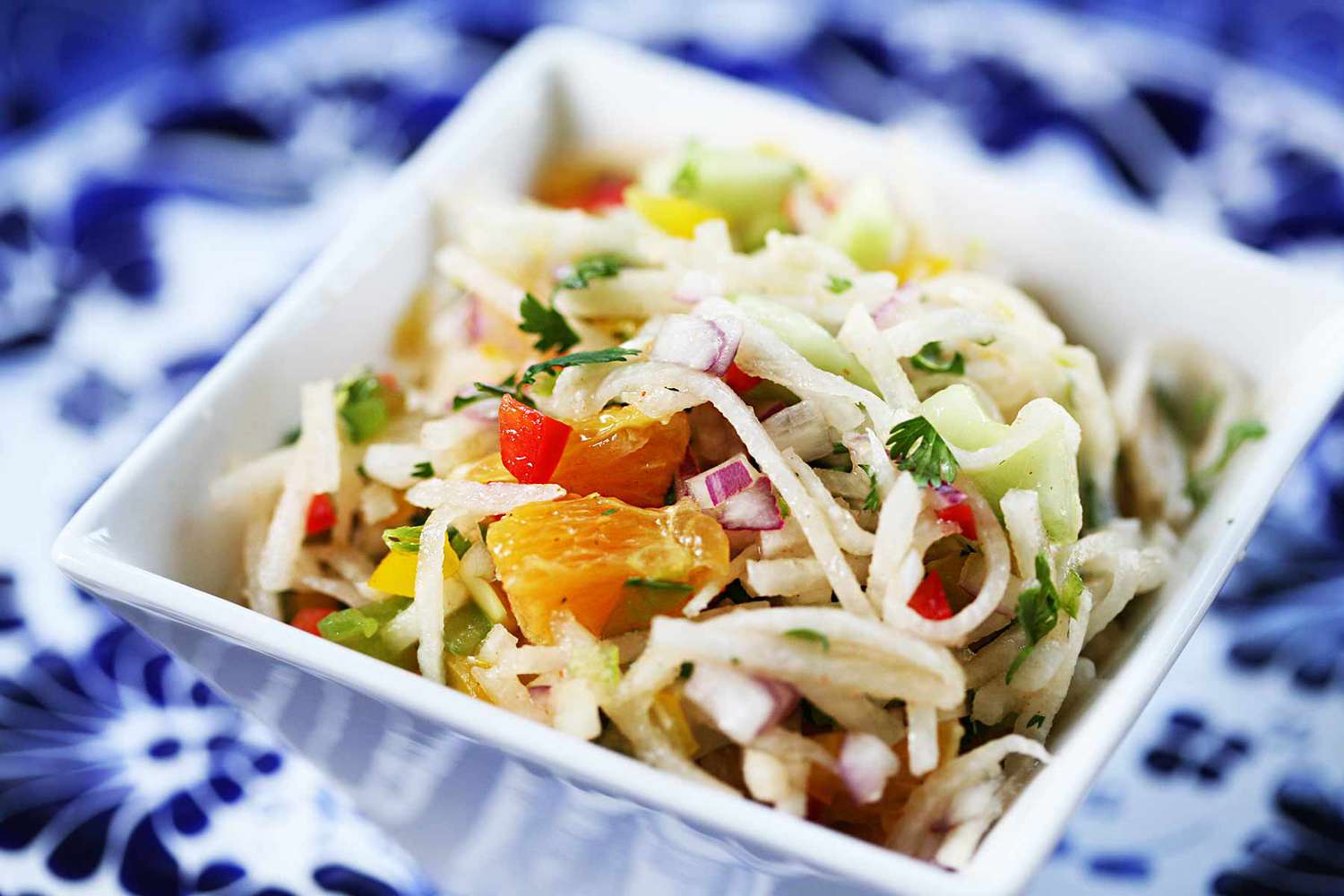Jicama: The Crunchy Root That Loves Your Gut

🎧 Prefer to listen? Here’s the narrated version of this post.
The first time you bite into jicama, you might be surprised. It looks like a potato, but the flavor and texture are closer to an apple crossed with a water chestnut—crisp, juicy, slightly sweet. Peel away its rough brown skin, and you’ve got one of the most refreshing, gut-friendly foods out there.
What Is Jicama?
Jicama (pronounced HEE-kah-mah) is the edible root of a vine in the legume family, originally from Mexico. While the plant produces beans, those aren’t edible. What we eat is the large, turnip-shaped root. It’s been a staple in Mexican street food for centuries, often served raw with a squeeze of lime, chili powder, and salt. You’ll also see it in Vietnamese spring rolls, Indonesian fruit salads like rojak, and Filipino dishes where it’s known as singkamas. After Spanish contact, jicama spread from Mexico across the Philippines and into much of Southeast Asia, where it adapted into new culinary traditions.
Cultural Significance
Jicama has a long history in Mesoamerica. Both the Aztecs and Mayans cultivated it, and it even appears in the Books of Chilam Balam, a set of Mayan manuscripts that reference its crisp, juicy nature. The word itself comes from the Nahuatl xicama, meaning “watery root.”

Beyond its daily use, jicama holds a symbolic role: in parts of Mexico, it is featured on Day of the Dead altars alongside sugar cane, peanuts, and tangerines, representing the harvest and sustenance for departed loved ones. In this sense, it’s more than a food—it’s a cultural offering tied to memory, continuity, and celebration.
Nutrition & Health Benefits
Prebiotic fiber powerhouse
Jicama is one of the richest food sources of inulin, a soluble fiber that resists digestion and feeds beneficial gut bacteria. Prebiotics like inulin help boost the growth of Bifidobacteria and Lactobacilli, which in turn may improve digestion, immunity, and even mood regulation through the gut-brain axis. And importantly, prebiotics feed our bacteria that make butyrate, an essential chemical for intestinal health.
Because of its high inulin content, some people (especially those with IBS or on a low-FODMAP diet) may experience gas, bloating, or loose stools if they eat large amounts of jicama. Introduce it gradually if you’re sensitive.
Blood sugar friendly
Despite being a root vegetable, jicama is low in starch and high in fiber. Its glycemic index is very low, meaning it doesn’t cause significant spikes in blood sugar. A cup of raw jicama has only ~50 calories and 6 grams of fiber.

Vitamin C boost
One serving provides approximately 40% of your daily minimum vitamin C intake, which is essential for collagen synthesis, immune defense, and acts as an antioxidant. That makes jicama a sneaky but excellent support for skin and vascular health.
Hydration & minerals
Jicama is ~85–90% water—perfect for hot weather or when you want something crisp and cooling. It also provides potassium and magnesium, which help regulate blood pressure and muscle function.
Sustainability
Like other members of the legume family, jicama vines can contribute to soil health and nitrogen cycling. While research on its nodulation is limited, legumes in general help reduce the need for synthetic fertilizer by partnering with nitrogen-fixing bacteria. That makes them valuable in crop rotation and regenerative farming systems.
In Mexico, jicama is sometimes cultivated alongside other traditional crops, echoing the milpa system—an ancient Mesoamerican practice of growing maize, beans, and squash together in a balanced ecosystem. This kind of intercropping improves soil fertility, biodiversity, and resilience.
Although most jicama in the U.S. is imported from Mexico, small farms in Texas, Florida, and California are beginning to grow it locally, often for farmers’ markets. That shift could mean more regional availability of this crunchy, sustainable root.

How to Choose & Store Jicama
When shopping, look for firm, heavy roots with smooth, dry skin. A few surface scars are normal, but avoid any that feel soft, shriveled, or have a moldy appearance. Medium-sized jicama (about the size of a grapefruit) tends to be the sweetest and crispest, while very large roots can sometimes be more fibrous.
You’ll usually see jicama available year-round in U.S. grocery stores, thanks to imports from Mexico. However, the peak season runs from late fall through spring (October–May). That’s when the roots are at their freshest and most abundant.
For storage, whole jicama actually prefers a cool, dry environment around 55–60°F, which is warmer than the average refrigerator. If you have a cool pantry, basement, or root cellar, that’s ideal and can keep jicama crisp for up to 2–3 weeks. In the fridge, it will still last a week or two, though the texture may gradually decline. Once peeled and cut, always refrigerate it in an airtight container (a damp paper towel helps keep it crunchy) and eat within 3–5 days. Freezing isn’t recommended—it ruins the texture.

How to Use Jicama
- Raw: Slice into sticks for dipping or toss into salads and slaws.
- Mexican-style: Squeeze on lime and sprinkle with chili powder and salt.
- Asian-inspired: Add thin slices to spring rolls or stir-fries for crunch.
- Baked “fries”: Though not as starchy as potatoes, they can be roasted into a lighter version of fries.
Important note: Always peel jicama before eating—the skin contains rotenone, a natural insecticide that isn’t safe for humans.
Final Thoughts
Jicama may not be the flashiest vegetable at the market, but its blend of gut-friendly fiber, vitamin C, cultural significance, and regenerative potential makes it worth a second look. If your memory of root vegetables is one of starchy and heavy flavors, jicama is a crisp reminder that roots can also be light and enlivening.
Have you tried jicama before? How do you like to eat it?
Resources
Cleveland Clinic on jicama
Food Revolution on jicama, including recipes
Benefits and potential side effects of inulin from Cleveland Clinic
Check out my full website.
Explore my bookshop.org store for books on the biome and related subjects.
(This blog is not intended to diagnose or treat disease. I am not a physician. Please consult your physician for any medical advice. Thanks.)
Affiliate note: I have affiliate relationships with Bookshop, Azure Standard, and Amazon. If you click through and make a purchase, I may earn a small commission at no extra cost to you. I strongly support both Azure and Bookshop for their mission-driven models, and I also include Amazon links, as I know many people find it the most convenient and affordable option. As an Amazon Associate, I earn from qualifying purchases.




